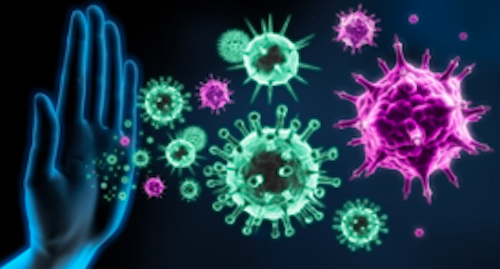Our immune system is incredibly complicated and essential for our survival. Without an immune system, our bodies would be open to attack from bacteria, viruses, parasites, and more. It is our immune system that keeps us healthy as we drift through a sea of pathogens.
Our immune system is our body’s version of the military - sworn to defend against all who threaten it, both foreign and domestic. Everyone’s immune system is different but, generally, it becomes stronger during adulthood as, by this time, we have been exposed to more pathogens and developed more immunity.
Our immune system protects against disease, infection, and helps us recover after an injury. Several different systems and cell types work in perfect synchrony (most of the time) throughout the body to fight off pathogens and clear up dead cells. It has some interesting soldiers that help make this possible.
Our immune system is a complex fighting system powered by five (5) liters of blood and lymph. Lymph is a clear and colorless liquid that passes throughout the tissues of the body. Together, these two fluids transport all the elements of the immune system so they can do their jobs.
White blood cells charge into battle at any sign of trouble. There are two different types of white blood cells: phagocytes and lymphocytes.
- Phagocytes can move through your blood vessels and tissue to ingest or absorb invaders. Phagocytes target organisms that cause disease (or pathogens) and toxins. Each pathogen carries a specific type of antigen, and each lymphocyte in your body carries antibodies meant to fight the antigens carried by pathogens.

- There are three (3) main types of lymphocytes in the body: B cells, T cells, and Natural killer cells.
- B cells create antibodies that attack bacteria, viruses, and toxins that enter the body.
- T cells kill cells in the body that have been overtaken by viruses or that have become cancerous.
- Like T cells, natural killer cells (cytotoxic T lymphocytes) kill infected or cancerous cells. But instead of producing antibodies, they make a special enzyme, or chemical, that kills the cells.
In humans, the blood–brain barrier, blood–cerebrospinal fluid barrier, and similar fluid–brain barriers separate the peripheral immune system from the neuroimmune system, which protects the brain.
These brave soldiers only live up to a few weeks, so it’s a good thing there’s a lot of them — a single drop of blood can contain up to 25,000 white blood cells.
How an Immune Response works?

The immune system needs to be able to tell self from non-self. It does this by detecting proteins that are found on the surface of all cells. It learns to ignore its own or self proteins at an early stage.
An antigen is any substance that can spark an immune response. In many cases, an antigen is a bacterium, fungus, virus, toxin, or foreign body. But it can also be one of our own cells that is faulty or dead. Initially, a range of cell types works together to recognize the antigen as an invader.
Your body creates new antibodies whenever it is infected with a new antigen. If the same antigen infects you a second time, your body can quickly make copies of the corresponding antibody to destroy it.
Once an antibody has been produced, a copy remains in the body so that if the same antigen appears again, it can be dealt with more quickly. That is why with some diseases, such as chickenpox, you only get it once as the body has a chickenpox antibody stored, ready and waiting to destroy it next time it arrives. This is called Immunity.
What is Immunity?
Immunity is the body’s defense system against infection and disease. White blood cells play a key role. Some rush to attack any harmful microbes that invade the body. Other white blood cells become specialists, adapted to fight particular pathogens. All of them work to keep the body as healthy as possible.
There are three types of immunity in humans called innate, adaptive, and passive:
i.) Innate immunity
We are all born with some level of immunity to invaders. Both Human and many animals immune systems, will attack foreign invaders from day one. This innate immunity includes the external barriers of our body — the first line of defence against pathogens — such as the skin and mucous membranes of the throat and gut.
This response provides Fast and General defence. If the pathogen manages to dodge the innate immune system, adaptive or acquired immunity kicks in.

ii.) Adaptive (acquired) immunity
This is a Complex and Targeted Response to Pathogens. This protection to pathogens develops as we go through life. As we are exposed to diseases or get vaccinated, we build up a library of antibodies to different pathogens. This is sometimes referred to as immunological memory because our immune system remembers previous enemies.

iii.) Passive immunity
This type of immunity is “borrowed” from another source, but it does not last indefinitely. For instance, a baby receives antibodies from the mother through the placenta before birth and in breast milk following birth. This passive immunity protects the baby from some infections during the early years of their life.



